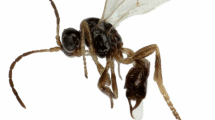Summary
Penetration of the stems ofAraujia sericofera, Asclepias curassavica, Cynanchum ellipticum andSarcostemma viminale by stylets of the aphidAphis nerii was studied with light and differential interference contrast microscopes. Of a total of 118 stylets and 446 stylet tracks observed in cross-sections of stems of the fourAsclepiadaceae, 97 stylets and 372 stylet tracks terminated within the internal primary phloem. Of the remainder, 15 stylets and 74 tracks terminated within the external primary phloem. 22 stylets and 179 of the stylet tracks penetrated the external phloem on the way to the internal phloem. Of these, only four stylets and 32 of the stylet tracks showed signs of attempted probes of the external phloem. It is suggested thatAphis nerii may obtain not only its essential food requirements but also cardiac glycosides as a basis for chemical aposematism.
Similar content being viewed by others
References
Botha, C. E. J., R. F. Evert, andR. D. Walmsley, 1975 a: Studies onGomphocarpus physcocarpus: Further evidence of preferential feeding by the aphidAphis nerii on the internal phloem. Protoplasma84, 345–356.
— — —, 1975 b: Observations of the penetration of the phloem ofNerium oleander (Linn.) by stylets of the aphid,Aphis nerii (B. de F.). Protoplasma86, 309–319.
Brower, L. P., P. B. McEvoy, K. L. Williamson, andM. A. Flannery, 1972: Variation in cardiac glycoside content of monarch butterflies from natural populations in eastern North America. Science (N.Y.)177, 426–429.
Brown, K. S., D. W. Cameron, andU. Weiss, 1969: Chemical constitutents of the bright orange aphidAphis nerii Fonscolombe. I. Neriaphin and 6-hydroxymusizin 8-o-D-Glucoside. Tetrahedron Lett.6, 471–476.
Culvenor, C. C. J., 1970: Toxic plants — a Re-evaluation. Search (Syd.)1 (3), 103–110.
Das, B., 1918: TheAphididae of Lahore. Mem. Indian Mus.6 (4), 135–274.
Duffey, S. S., andG. G. E. Scudder, 1972: Cardiac glycosides in North AmericanAsclepia-daceae, a basis for unpalatability in brightly colouredHemiptera andColeoptera. J. Insect Physiol.18 (1), 63–78.
Ehrhardt, P., 1968: Nachweis einer durch symbiotische Mikroorganismen bewirkten Sterin-synthese in künstlich ernährten Aphiden. Experientia24, 82–83.
Eisner, T., 1970: Chemical defence against predation in arthropods. In: Chemical Ecology (Sondheimer, E., andJ. B. Simeone, eds.), pp. 157–217. New York: Academic Press.
Euw, J. von, L. Fishelson, J. A. Parsons, T. Reichstein, andM. Rothschild, 1967: Cardenolides (heart poisons) in a grasshopper feeding on milkweeds. Nature (Lond.)214 (5083), 35–39.
Evert, R. F., W. Eschrich, J. T. Medler, andF. J. Alfeiri, 1968: Observations of the penetration of linden branches by stylets of the aphid,Longistigma caryae (Han.). Amer. J. Bot.55, 860–874.
Feir, D., J. S. Suen, 1971: Cardenolides in the milkweed plant and feeding by the milkweed bug. Ann. ent. Soc. Amer.64 (5), 1173–1174.
Fraenkel, G. S., 1959: The raison d'être of secondary plant substances. Science (N.Y.)129, 1466–1470.
Iperti, G., 1966: Specificity of aphidophagous coccinellids in South Eastern France. In: Ecology of aphidophagous insects. Proceedings of a symposium held in Liblice near Prague, 1965 (Hodek, I., ed.), pp. 31–34. The Hague: Dr. W. Junk — Prague: Academia.
Ismail, I. I., andS. M. Swailem, 1971: Seasonal occurrence ofAphis nerii Boyer in Giza region (Egypt) (Hemiptera-Homoptera: Aphididae). Bull. Soc. ent. Egypte55, 231–238.
Kedde, D. L., 1947: Bijdrage tot het chemisch onderzoek van digitalispreparaten. Pharm. Weekbl. Ned.82, 741–757.
Kennedy, J. S., 1958: Physiological condition of the host plant and susceptibility to aphid attack. Entomologia exp. appl.1, 50–65.
Kupchan, S. M., J. R. Knox, J. E. Kelsey, andJ. A. S. Renauld, 1964: Calotropin, a cytotoxic principle isolated fromAsclepias curassavica L. Science (N.Y.)146, 1685.
Malcolm, S. B., 1976: An investigation of plant-derived cardiac glycosides as a possible basis for aposematism in the aphidophagous hoverflyIschiodon aegyptius (Wiedemann) (Diptera, Syrphidae). M. Sci. thesis, Rhodes University, Grahamstown, South Africa.
Paris, R., 1963: The distribution of plant glycosides. In: Chemical Plant Taxonomy (Swain, T., ed.), pp. 337–358. London: Academic Press.
Reichstein, T., 1967: Cardenolide (Herzwirksame Glykoside) als Abwehrstoffe bei Insekten. Naturw. Rdsch.20, 499–511.
—,J. von Euw, J. A. Parsons, andM. Rothschild, 1968: Heart poisons in the monarch butterfly. Science (N.Y.)161, 861–866.
Rothschild, M., J. von Euw, andT. Reichstein, 1970: Cardiac glycosides in the Oleander aphidAphis nerii. J. Insect Physiol.16, 1141–1145.
Sass, J. E., 1958: Botanical Microtechnique. 3rd ed., Ames: Iowa State College Press.
Schaub, F., H. Kaufman, W. Stocklin, undT. Reichstein, 1968: Die Pregnangglykoside der oberirdischen Teile vonSarcostemma viminale (L.) R. Br. (Glykoside und Aglykone 307. Mitteilung). Helv. chim. Acta51 (5), 738–766.
Singh, B., andR. P. Rastogi, 1969: Chemical investigation ofAsclepias curassavica Linn. Indian. J. Chem.7, 1105–1110.
Southwood, T. R. E., 1973: The insect/plant relationship — an evolutionary perspective. In: Insect/plant relationshipsvan Emden, H. F., ed.). Symp. R. ent. Soc. (Lond.)6, 3–30.
Trimen, R., 1887: South African butterflies. A monograph of the extratropical species, Volume 1:Nymphalidae, pp. 355. London: Trübner & Co.
Tschesche, R., D. Forstmann undD. K. M. Rao, 1958: Zur Kenntnis der Cardenolid-Inhaltsstoffe vonAsclepias curassavica L. Chem. Ber.91, 1204.
—,G. Snatzke, undG. Grimmer, 1959: Calotropagenin ausAsclepias curassavica L. Naturwissenschaften.46, 263–264.
Waldi, D., 1959: Chromatography — with particular consideration of paper chromatography, pp. 185. Darmstadt: E. Merck.
Watt, J. M., andM. G. Breyer-Brandwijk, 1962: The medicinal and poisonous plants of Southern and Eastern Africa, 2nd ed., pp. 1457. Edinburgh-London: E. & S. Living-stone Ltd.
Author information
Authors and Affiliations
Rights and permissions
About this article
Cite this article
Botha, C.E.J., Malcolm, S.B. & Evert, R.F. An investigation of preferential feeding habit in fourAsclepiadaceae by the Aphid,Aphis nerii B. de F.. Protoplasma 92, 1–19 (1977). https://doi.org/10.1007/BF01280197
Received:
Issue Date:
DOI: https://doi.org/10.1007/BF01280197




